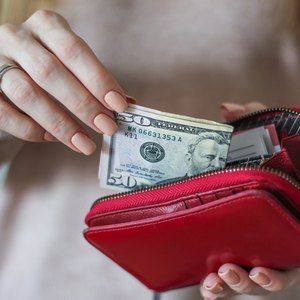
When you deposit cash, the bank doesn't have to wait for funds confirmation or clearance like it does with checks and other near-cash negotiable items. Cash makes things simple. When a bank makes a ledger error or has computer problems, a cash deposit can be more difficult to prove. That's why it's imperative to keep teller and ATM receipts.
Tips
You can trace cash deposits by logging in to your online account, checking your balance on an ATM or by reviewing your monthly bank statement. It is always important to keep teller and ATM receipts in case there are any discrepancies.
Teller Transactions
When depositing cash, making a deposit at a teller's window is the best way to ensure your funds are secure. Tellers count cash and verify the deposit as part of the transaction, often using cash counting machines for added accuracy. You and the teller can work out any discrepancies in your accounting on the spot and the completed deposit is instant at most banks.
Some banks may be able to provide you with copies of historic deposit receipts, but it's usually best to hold on to your copy in case there's any dispute later on.
Teller Receipts
Receipts from teller transactions have receipt numbers or codes. If your transaction doesn't appear correctly on your statement or bank balance, you can use the coded receipt as proof of your cash deposit. The bank can then investigate the mistake and correct the error.
Bank policies vary on correcting errors in cash deposits. Some will instantly credit you the amount missing upon presentation of the receipt while others will wait for a completed investigation. An authentic receipt with a transaction number usually gives a bank what it needs to track down a deposit and associated errors.
ATM Transactions
Cash deposits at ATMs are riskier than teller deposits. Major banks include provisions in their account agreements that ATM deposits are subject to verification. If an ATM malfunctions and a bank officer cannot find or verify your cash deposit, it can be difficult to prove your deposit was made at all. If you see an ATM malfunction as you're using it, or it fails to give you a receipt for your deposit, it's a good idea to contact your bank right away or as soon as the bank is open if it's closed at the time.
Some later model ATMs have more sophisticated cash counting and verifying equipment and issue receipts that show the denominations received in cash deposits. This gives you proof and a greater likelihood of success in tracking missing deposits. No matter what, ATMs issue receipts with transaction numbers that can help bankers track your deposit and try to resolve any mistakes.
Night Drops
Although they are less common, some banks still have night drop slots for after-hours deposits. Customers leave deposits with deposit slips in envelopes or merchant pouches and tellers run the transactions the next business day. Because a depositor has no official record of leaving the cash, these transactions aren't always traceable – especially if a teller doesn't find them. Customers who want assurance of receipt and crediting of their cash deposits should visit a teller.
References
- SUNY Research Foundation: Depositing Cash Receipts to an RF Bank Account
- TD Bank: Can I Get Past Cash Deposit Slip From Bank?
- NerdWallet: What to Do if an ATM Eats Your Deposit
- Cash Vault Services – Wells Fargo Commercial
- Wells Fargo. "Mobile Deposit." Accessed Jan. 11, 2020.
- Consumer Reports. "Pros and Cons of Mobile Check Deposit." Accessed Feb. 5, 2020.
- Capital One. "Can I Deposit a Check at an ATM?" Accessed Jan. 11, 2020.
- Wells Fargo. "Envelope-Free ATMs." Accessed Jan. 11, 2020.
- Wells Fargo. "Deposit Questions: When Will My Deposit Be Credited to My Account?" Accessed Jan. 11, 2020.
- Consumer Financial Protection Bureau. "How Quickly Can I Get Money After I Deposit a Check Into My Checking Account? What Is a Deposit Hold?" Accessed Jan. 11, 2020.
- Capital One. "How Do I Make a Deposit?" Accessed Jan. 11, 2020.
- CO-OP Financial Services. "CO-OP Shared Branch." Accessed Jan. 11, 2020.
Writer Bio
Eric Feigenbaum started his career in print journalism, becoming editor-in-chief of "The Daily" of the University of Washington during college and afterward working at two major newspapers. He later did many print and Web projects including re-brandings for major companies and catalog production.

